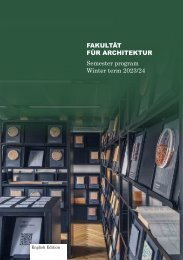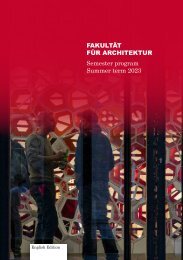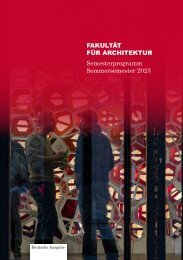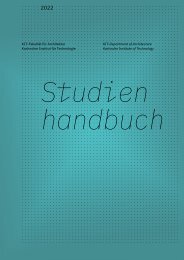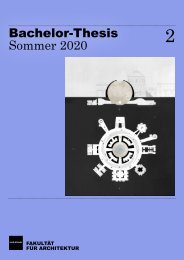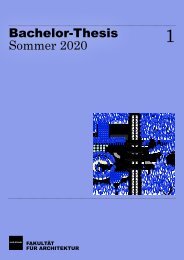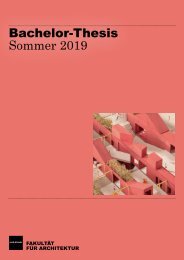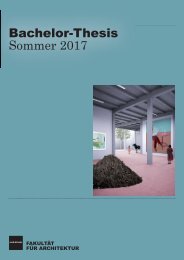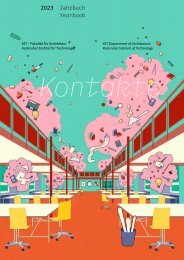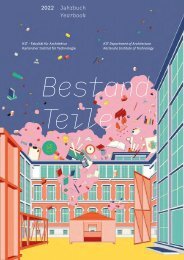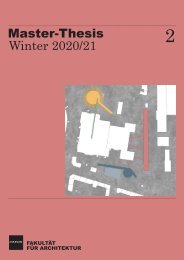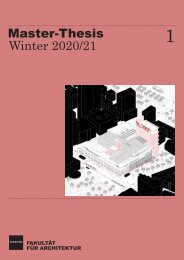Salutogenese – Das Jahrbuch der KIT-Fakultät für Architektur 2021
Im Oktober 2021 ist das neue Jahrbuch der Fakultät erschienen: 374 Seiten Diskurs, Dokumentation und Data aus Lehre, Forschung und Fakultätsleben. In deutsch und englisch.
Im Oktober 2021 ist das neue Jahrbuch der Fakultät erschienen: 374 Seiten Diskurs, Dokumentation und Data aus Lehre, Forschung und Fakultätsleben. In deutsch und englisch.
Erfolgreiche ePaper selbst erstellen
Machen Sie aus Ihren PDF Publikationen ein blätterbares Flipbook mit unserer einzigartigen Google optimierten e-Paper Software.
Expansion vs. Rezession<br />
Szenarien <strong>für</strong> den<br />
Campus Süd<br />
Expansion vs. Recession<br />
Scenarios for the<br />
Campus South<br />
Die Zukunft erreicht uns schneller, als wir denken<br />
– damit Städte <strong>für</strong> die Zukunft gerüstet sind,<br />
müssen sie weit vorausdenken. Auch das Leben<br />
auf dem Campus verän<strong>der</strong>t sich dynamisch und<br />
bedarf planerischer Überlegungen. Wie könnte<br />
die bauliche und freiräumliche Entwicklung aussehen?<br />
Welchen Charakter soll <strong>der</strong> Campus haben,<br />
welche Dichte soll er bekommen und welche<br />
Bewegungs- und Begegnungsräume? Sollte<br />
<strong>der</strong> Campus <strong>der</strong> Lehre und Forschung vorbehalten<br />
sein o<strong>der</strong> sich stärker mit <strong>der</strong> Stadt vernetzen?<br />
Wie verän<strong>der</strong>t sich das Leben auf dem<br />
Campus, wenn es mehr digitale Lehre und mehr<br />
Homeoffice gibt?<br />
Im Rahmen des Stegreifs sollten unter<br />
dem Motto Was wäre, wenn ...? zwei Szenarien<br />
<strong>für</strong> den Campus Süd entwickelt werden. Aufgabe<br />
war es, stringente und ggf. polarisierende Möglichkeitsräume<br />
<strong>für</strong> die funktionale und räumliche<br />
Entwicklung des Universitätsgeländes zu entwerfen<br />
und bildhaft darzustellen.<br />
Die Arbeit Expansion vs. Rezession stellt<br />
ein positives Wachstumsszenario einer negativen,<br />
repressiven Entwicklung gegenüber. Das<br />
positive Szenario geht davon aus, dass die soziale<br />
Isolation, die den Alltag in <strong>der</strong> Pandemie bestimmt,<br />
vorüber ist. Die Studierenden suchen<br />
das soziale Miteinan<strong>der</strong> und den Austausch, die<br />
Interaktion und gemeinsame Aktivitäten auf<br />
dem Campus. Die Studenten verbringen so viel<br />
Zeit wie möglich auf dem Campus – Tag und<br />
Nacht. Räumliche Kapazitäten <strong>für</strong> den zunehmenden<br />
Entwicklungsdruck fehlen. Schnelle Lösungen<br />
sind gefragt, die mit temporären und flexiblen<br />
Bauten sowie Schnellbausystemen<br />
gefunden werden. Der Campus erfährt Boom-<br />
Jahre und wird zum beliebtesten Ort in <strong>der</strong> Stadt.<br />
The future is closer as we think – for cities to be<br />
ready for the future, they need to think far ahead.<br />
The life on the campus is changing dynamically<br />
and requires planning consi<strong>der</strong>ations. How could<br />
the structural and open-space development look<br />
like? What character should the campus have,<br />
what density should it have, and what spaces for<br />
movement and encounter? Should the campus<br />
be reserved for teaching and research, or should<br />
it become more interconnected with the city?<br />
How will life on campus change, if there will be<br />
more digital teaching and more home office?<br />
As part of the Stegreif project, two scenarios<br />
for the South Campus had to be developed un<strong>der</strong><br />
the motto What if...?. The task was to design<br />
clear and possibly polarizing options for the<br />
functional and spatial development of the university<br />
campus and visualize it.<br />
The work Expansion vs. Recession contrasts<br />
a positive growth scenario with a negative,<br />
repressive development. The positive scenario<br />
assumes that the social isolation, that defines<br />
everyday life during the pandemic, will be over.<br />
Students seek social interaction, exchange and<br />
shared activities on the campus. Students spend<br />
as much time as possible on the campus – day<br />
and night. Spatial capacity for increasing development<br />
pressures is lacking. Quick solutions<br />
are needed, which are implemented with temporary<br />
and flexible buildings as well as rapid<br />
construction systems. The campus experiences<br />
boom years and becomes the most popular<br />
place in the city.<br />
Stegreif Impromptu<br />
MA<br />
Wintersemester 2020/21<br />
Prof. Dr. Barbara Engel<br />
Anna Kuzyshyn<br />
Simon Waschto<br />
G Axonometrie<br />
270<br />
Engel




